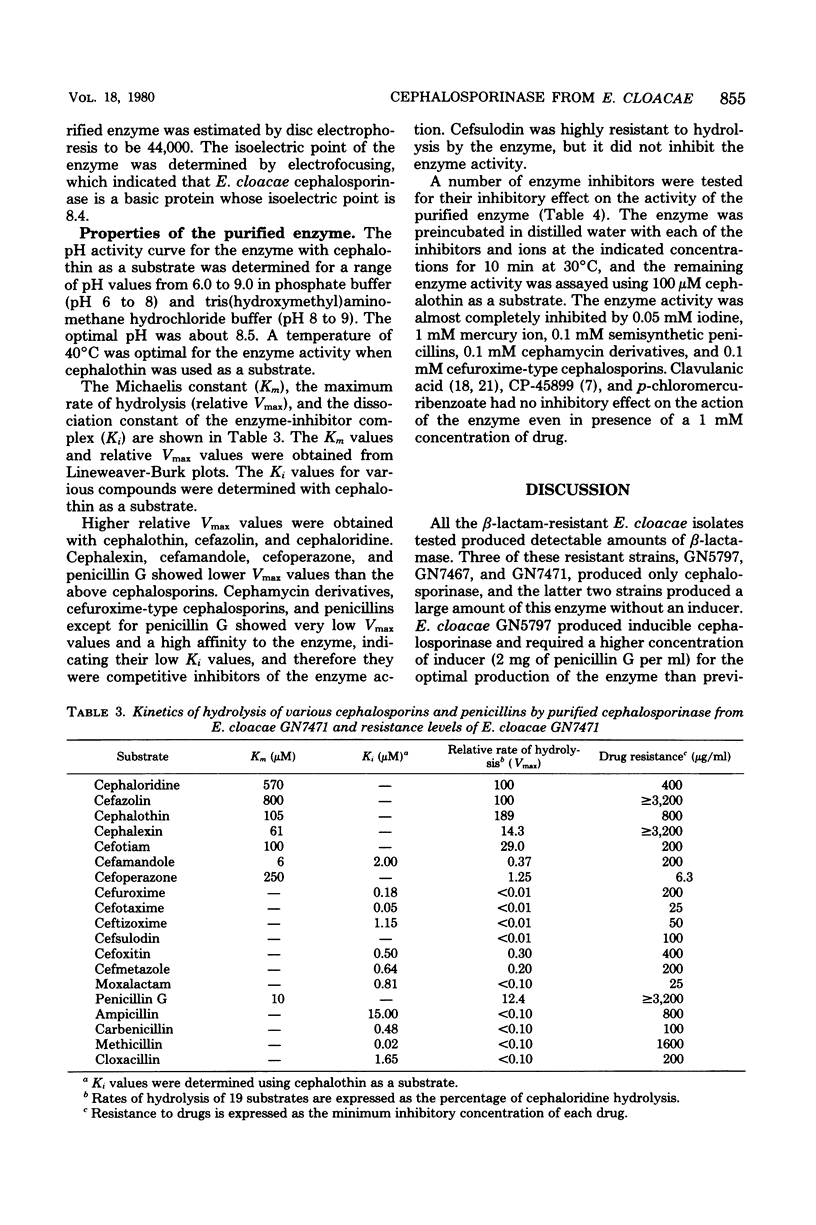Abstract
A cephalosporin beta-lactamase (cephalosporinase) was extracted from Enterobacter cloacae GN7471 and purified by means of column chromatography. The resulting preparation gave a single protein band upon polyacrylamide gel electrophoresis. The enzyme's isoelectric point was 8.4, and its molecular weight was 44,000. The optimal pH was 8.5, and the optimal temperature was 40 degrees C. The enzyme hydrolyzed cephalosporins much more readily than penicillins. The enzyme activity was inhibited by iodine, semisynthetic penicillins, cefuroxime-type cephalosporins, and cephamycin derivatives. The enzymological properties of the purified enzyme were compared with those of beta-lactamases derived from other gram-negative enteric bacteria.
Full text
PDF




Selected References
These references are in PubMed. This may not be the complete list of references from this article.
- Barthelemy M., Guionie M., Labia R. Beta-lactamases: determination of their isoelectric points. Antimicrob Agents Chemother. 1978 Apr;13(4):695–698. doi: 10.1128/aac.13.4.695. [DOI] [PMC free article] [PubMed] [Google Scholar]
- Cole M., Elson S., Fullbrook P. D. Inhibition of the -lactamases of Escherichia coli and Klebsiella aerogenes by semi-synthetic penicillins. Biochem J. 1972 Mar;127(1):295–308. doi: 10.1042/bj1270295. [DOI] [PMC free article] [PubMed] [Google Scholar]
- DAVIS B. J. DISC ELECTROPHORESIS. II. METHOD AND APPLICATION TO HUMAN SERUM PROTEINS. Ann N Y Acad Sci. 1964 Dec 28;121:404–427. doi: 10.1111/j.1749-6632.1964.tb14213.x. [DOI] [PubMed] [Google Scholar]
- Fleming P. C., Goldner M., Glass D. G. Inhibition of Aerobacter cephalosporin beta-lactamase by penicillins. J Bacteriol. 1969 May;98(2):394–397. doi: 10.1128/jb.98.2.394-397.1969. [DOI] [PMC free article] [PubMed] [Google Scholar]
- Fu K. P., Neu H. C. Comparative inhibition beta-lactamases by novel beta-lactam compounds. Antimicrob Agents Chemother. 1979 Feb;15(2):171–176. doi: 10.1128/aac.15.2.171. [DOI] [PMC free article] [PubMed] [Google Scholar]
- Fujii-Kuriyama Y., Yamamoto M., Sugawara S. Purification and properties of beta-lactamase from Proteus morganii. J Bacteriol. 1977 Sep;131(3):726–734. doi: 10.1128/jb.131.3.726-734.1977. [DOI] [PMC free article] [PubMed] [Google Scholar]
- Goldner M., Glass D. G., Fleming P. C. Characteristics of Aerobacter beta-lactamase. Can J Microbiol. 1968 Feb;14(2):139–145. doi: 10.1139/m68-023. [DOI] [PubMed] [Google Scholar]
- HAMILTON-MILLER J. M. INDUCIBLE PENICILLINASE IN PROTEUS MORGANI. Biochem Biophys Res Commun. 1963 Sep 10;13:43–48. doi: 10.1016/0006-291x(63)90159-1. [DOI] [PubMed] [Google Scholar]
- Hamilton-Miller J. M. Hydrolysis of cephalosporins by beta-lactamases from gram-negative bacteria. Nature. 1967 Jun 24;214(5095):1333–1334. doi: 10.1038/2141333a0. [DOI] [PubMed] [Google Scholar]
- Hennessey T. D. Inducible beta-lactamase in Enterobacter. J Gen Microbiol. 1967 Nov;49(2):277–285. doi: 10.1099/00221287-49-2-277. [DOI] [PubMed] [Google Scholar]
- Hennessey T. D., Richmond M. H. The purification and some properties of a beta-lactamase (cephalosporinase) synthesized by Enterobactercloacae. Biochem J. 1968 Sep;109(3):469–473. doi: 10.1042/bj1090469. [DOI] [PMC free article] [PubMed] [Google Scholar]
- Hirai K., Iyobe S., Inoue M., Mitsuhashi S. Purification and properties of a new beta-lactamase from Pseudomonas cepacia. Antimicrob Agents Chemother. 1980 Mar;17(3):355–358. doi: 10.1128/aac.17.3.355. [DOI] [PMC free article] [PubMed] [Google Scholar]
- Jack G. W. The purification and some properties of a -lactamase sensitive to inhibition by p-chloromercuribenzoate. Biochim Biophys Acta. 1971 Nov 13;250(2):428–436. doi: 10.1016/0005-2744(71)90199-9. [DOI] [PubMed] [Google Scholar]
- LOWRY O. H., ROSEBROUGH N. J., FARR A. L., RANDALL R. J. Protein measurement with the Folin phenol reagent. J Biol Chem. 1951 Nov;193(1):265–275. [PubMed] [Google Scholar]
- Letarte R., Devaud-Felix M., Pechere J. C., Allard-Leprohon D. Enzymatic and immunological characterization of a new cephalosporinase from Enterobacter aerogenes. Antimicrob Agents Chemother. 1977 Aug;12(2):201–205. doi: 10.1128/aac.12.2.201. [DOI] [PMC free article] [PubMed] [Google Scholar]
- NOVICK R. P. Micro-iodometric assay for penicillinase. Biochem J. 1962 May;83:236–240. doi: 10.1042/bj0830236. [DOI] [PMC free article] [PubMed] [Google Scholar]
- O'Callaghan C. H., Muggleton P. W. The action of cephaloridine with cloxacillin or methicillin against beta-lactamase-producing gram-negative bacteria. J Gen Microbiol. 1967 Sep;48(3):449–460. doi: 10.1099/00221287-48-3-449. [DOI] [PubMed] [Google Scholar]
- Reading C., Cole M. Clavulanic acid: a beta-lactamase-inhiting beta-lactam from Streptomyces clavuligerus. Antimicrob Agents Chemother. 1977 May;11(5):852–857. doi: 10.1128/aac.11.5.852. [DOI] [PMC free article] [PubMed] [Google Scholar]
- Richmond M. H., Sykes R. B. The beta-lactamases of gram-negative bacteria and their possible physiological role. Adv Microb Physiol. 1973;9:31–88. doi: 10.1016/s0065-2911(08)60376-8. [DOI] [PubMed] [Google Scholar]
- Ross G. W., Boulton M. G. Purification of beta-lactamases on QAE-sephadex. Biochim Biophys Acta. 1973 Jun 6;309(2):430–439. doi: 10.1016/0005-2744(73)90041-7. [DOI] [PubMed] [Google Scholar]
- Sawai T., Mitsuhashi S., Yamagishi S. Drug resistance of enteric bacteria. XIV. Comparison of beta-lactamases in gram-negative rod bacteria resistant to alpha-aminobenzylpenicillin. Jpn J Microbiol. 1968 Dec;12(4):423–434. doi: 10.1111/j.1348-0421.1968.tb00415.x. [DOI] [PubMed] [Google Scholar]
- Sawai T., Takahashi K., Yamagishi S., Mitsuhashi S. Variant of penicillinase mediated by an R factor in Escherichia coli. J Bacteriol. 1970 Nov;104(2):620–629. doi: 10.1128/jb.104.2.620-629.1970. [DOI] [PMC free article] [PubMed] [Google Scholar]
- Sykes R. B., Matthew M. The beta-lactamases of gram-negative bacteria and their role in resistance to beta-lactam antibiotics. J Antimicrob Chemother. 1976 Jun;2(2):115–157. doi: 10.1093/jac/2.2.115. [DOI] [PubMed] [Google Scholar]
- Une T., Mitsuhashi S. Antimicrobial evaluation of cefoxitin: a new semisynthetic cephamycin. Comparative studies with cefazolin and cefalotin. Arzneimittelforschung. 1977;27(1):89–93. [PubMed] [Google Scholar]
- Weber K., Osborn M. The reliability of molecular weight determinations by dodecyl sulfate-polyacrylamide gel electrophoresis. J Biol Chem. 1969 Aug 25;244(16):4406–4412. [PubMed] [Google Scholar]
- Yaginuma S., Sawai T., Ono H., Yamagishi S., Mitsuhashi S. Biochemical properties of a cephalosporin beta-lactamase from Pseudomonas aeruginosa. Jpn J Microbiol. 1973 Mar;17(2):141–149. doi: 10.1111/j.1348-0421.1973.tb00718.x. [DOI] [PubMed] [Google Scholar]
- Yaginuma S., Sawai T., Yamagishi S., Mitsuhashi S. Beta-lactamase formation and resistance of Proteus morganii to various penicillins and cephalosporins. Jpn J Microbiol. 1974 Mar;18(2):113–118. doi: 10.1111/j.1348-0421.1974.tb00798.x. [DOI] [PubMed] [Google Scholar]


